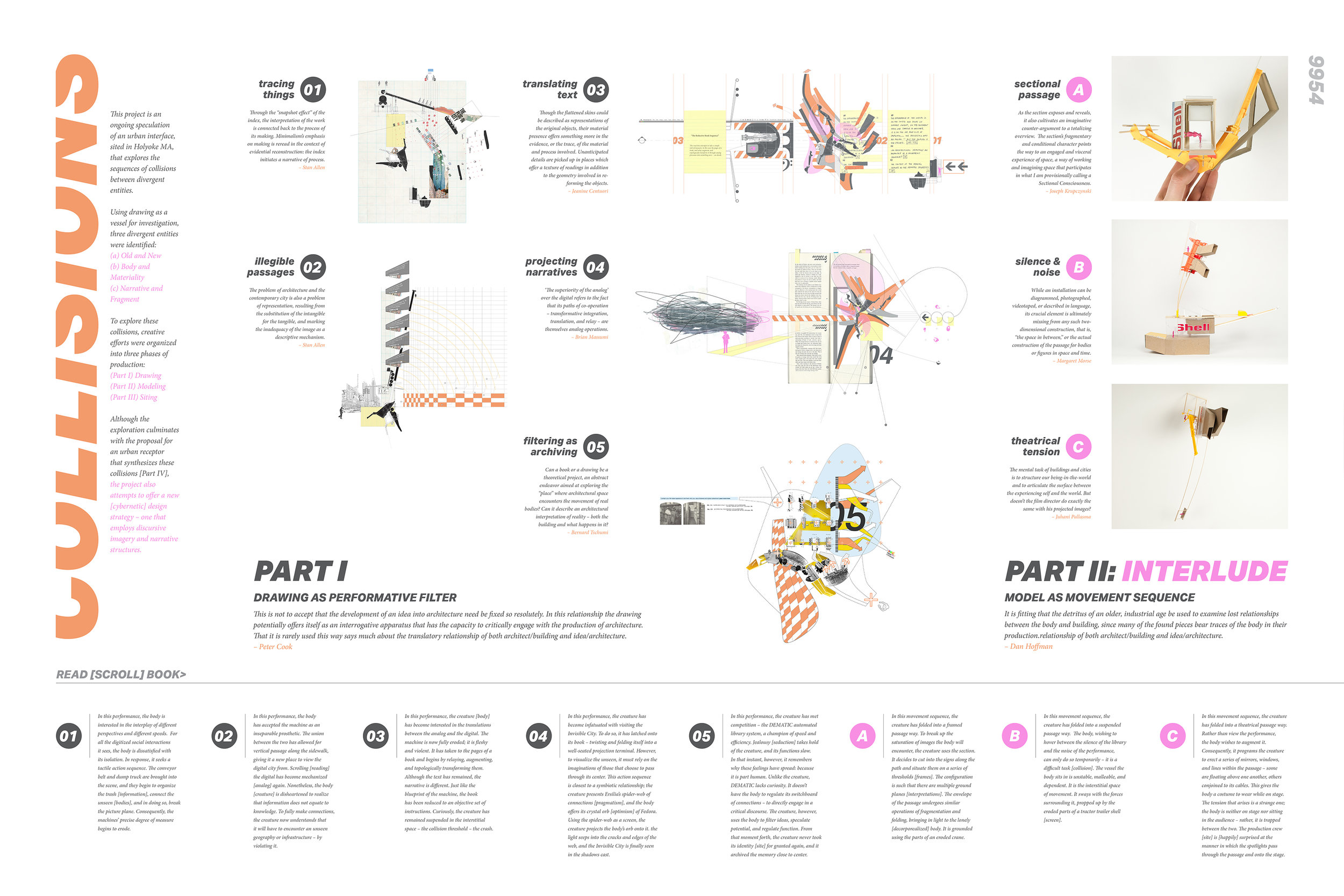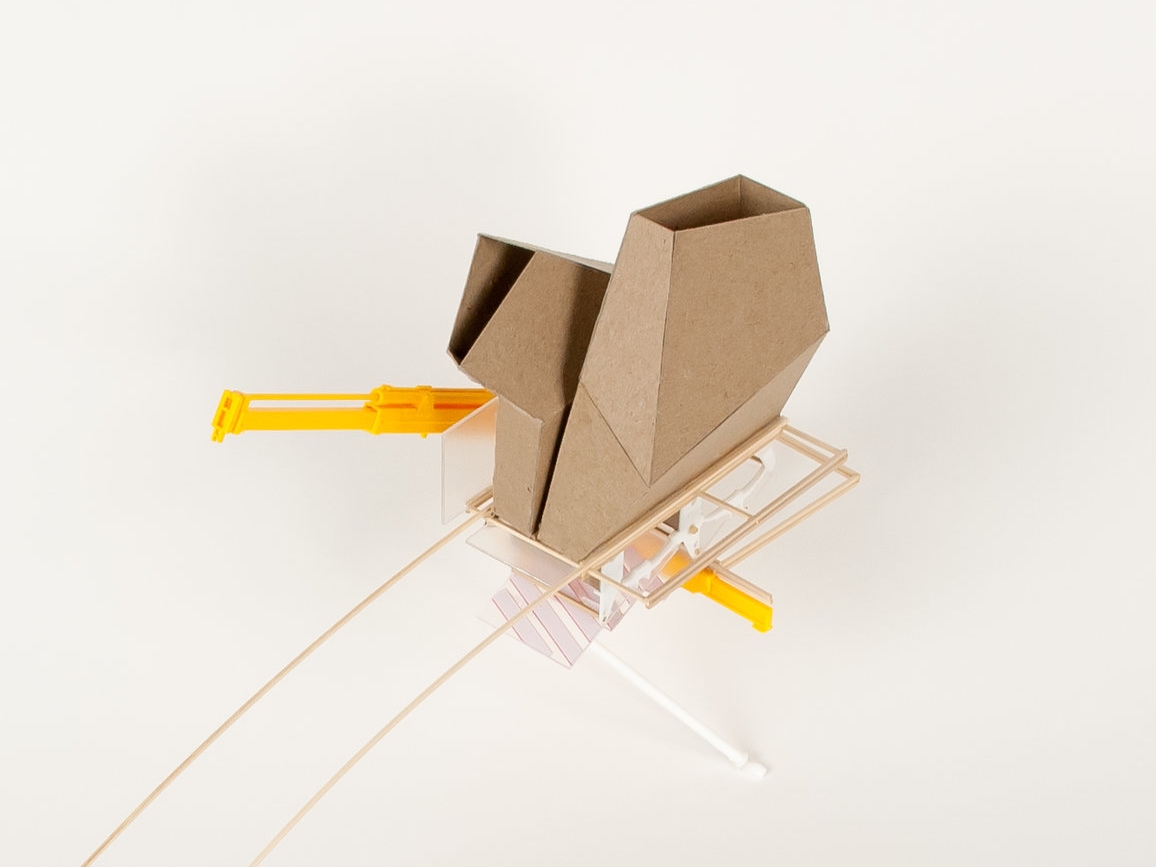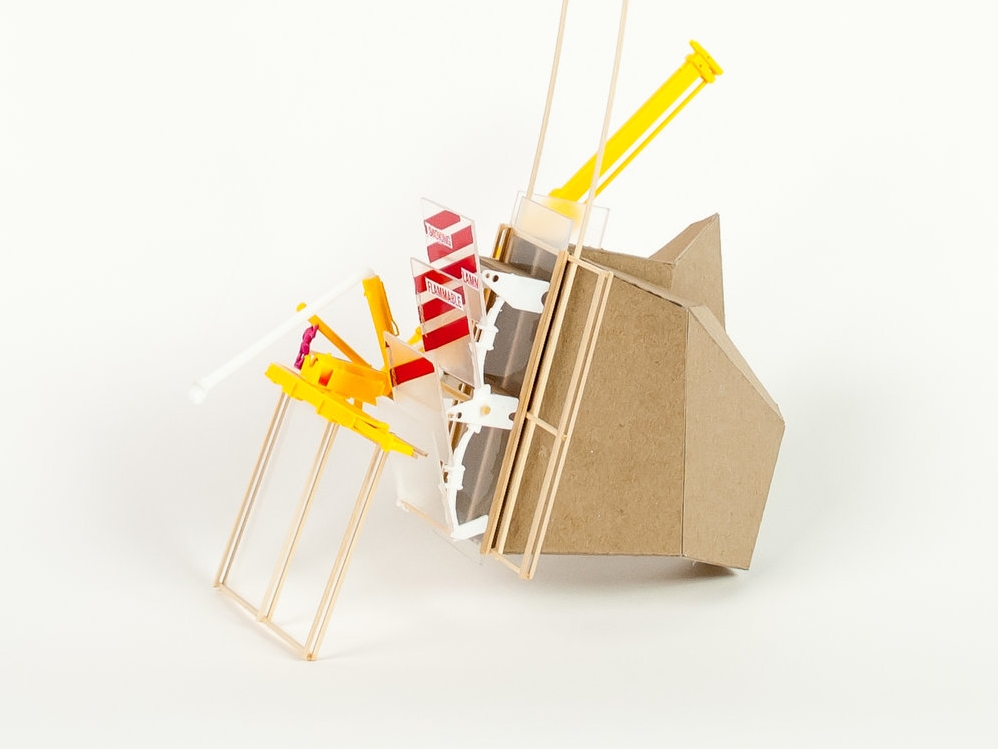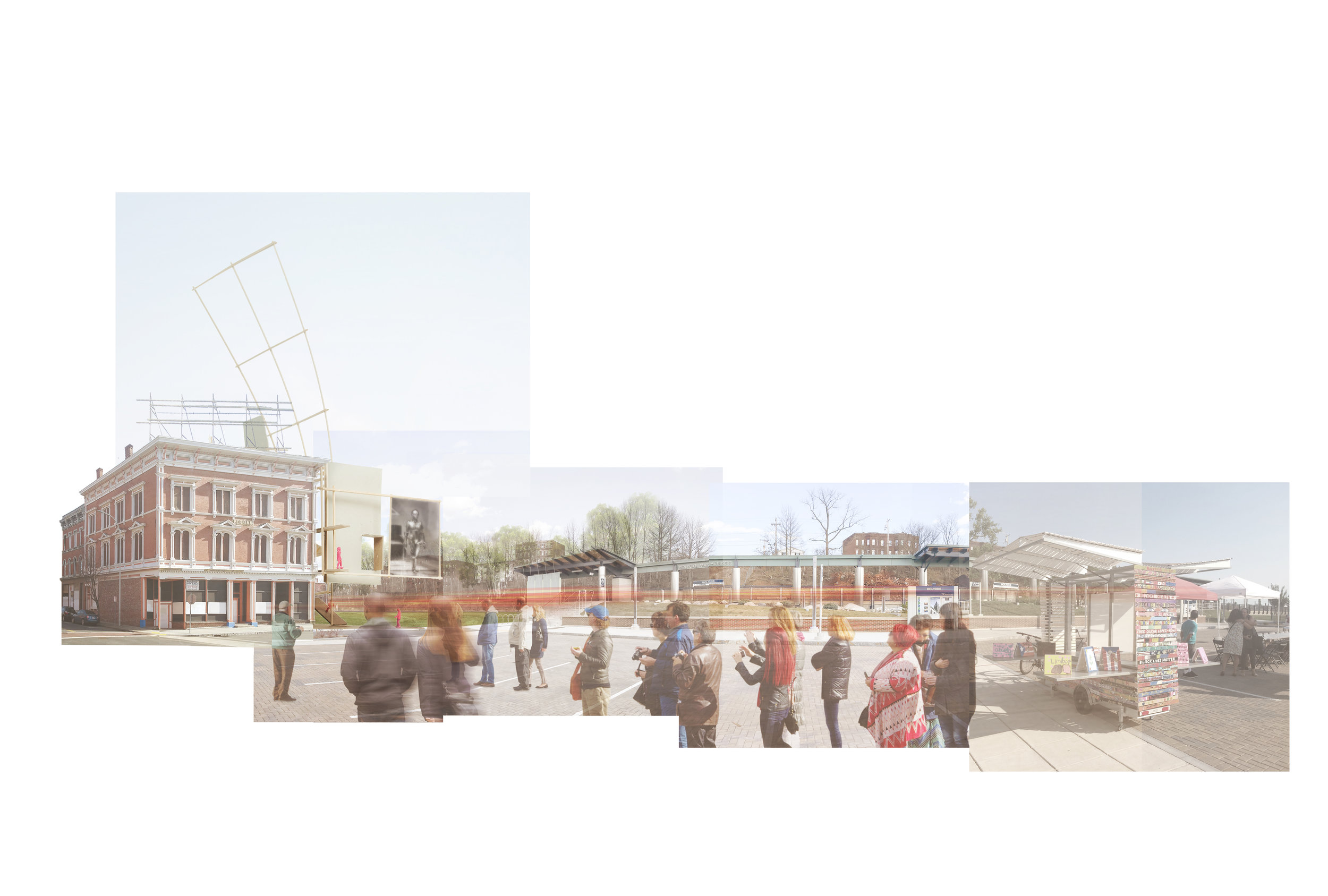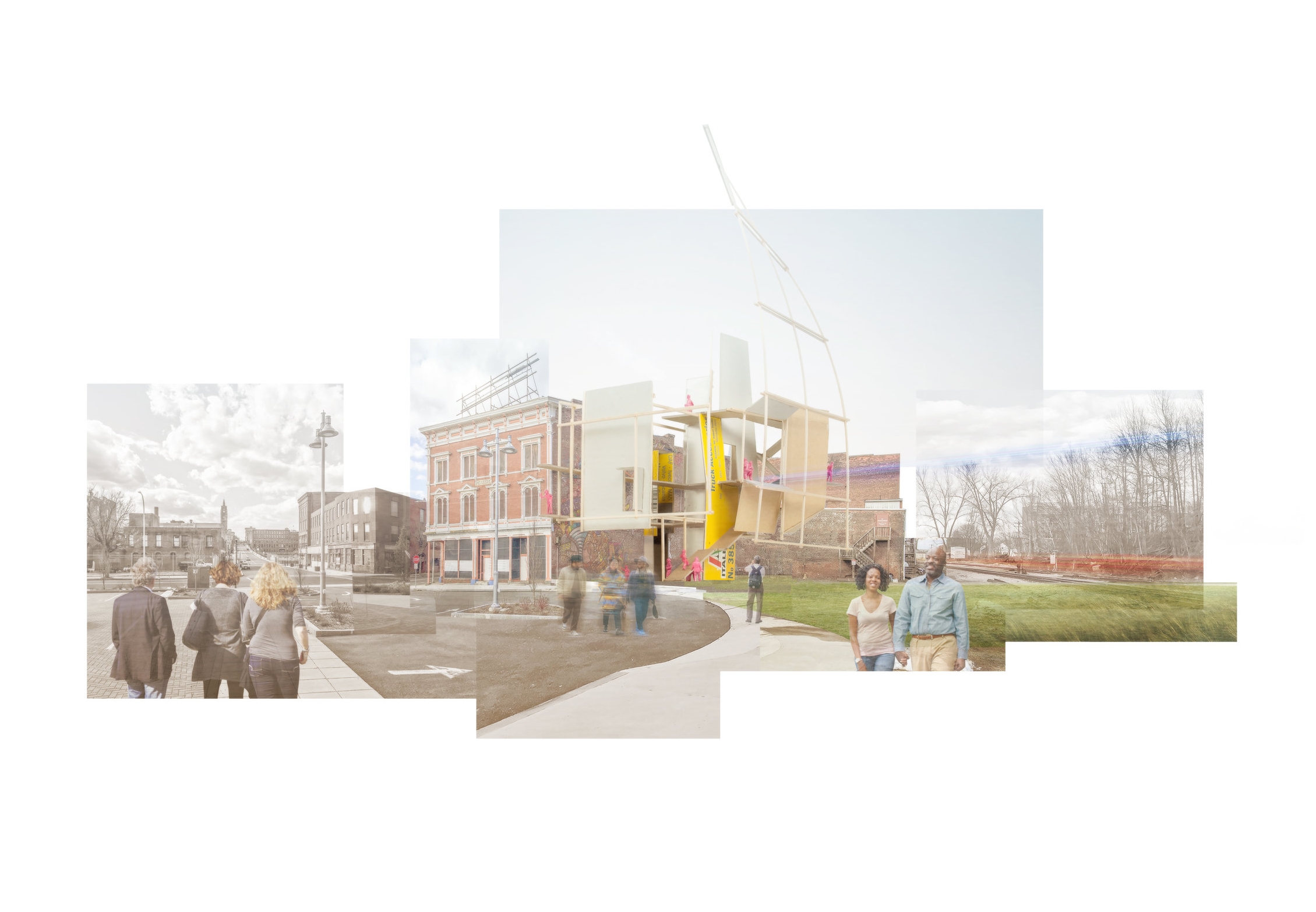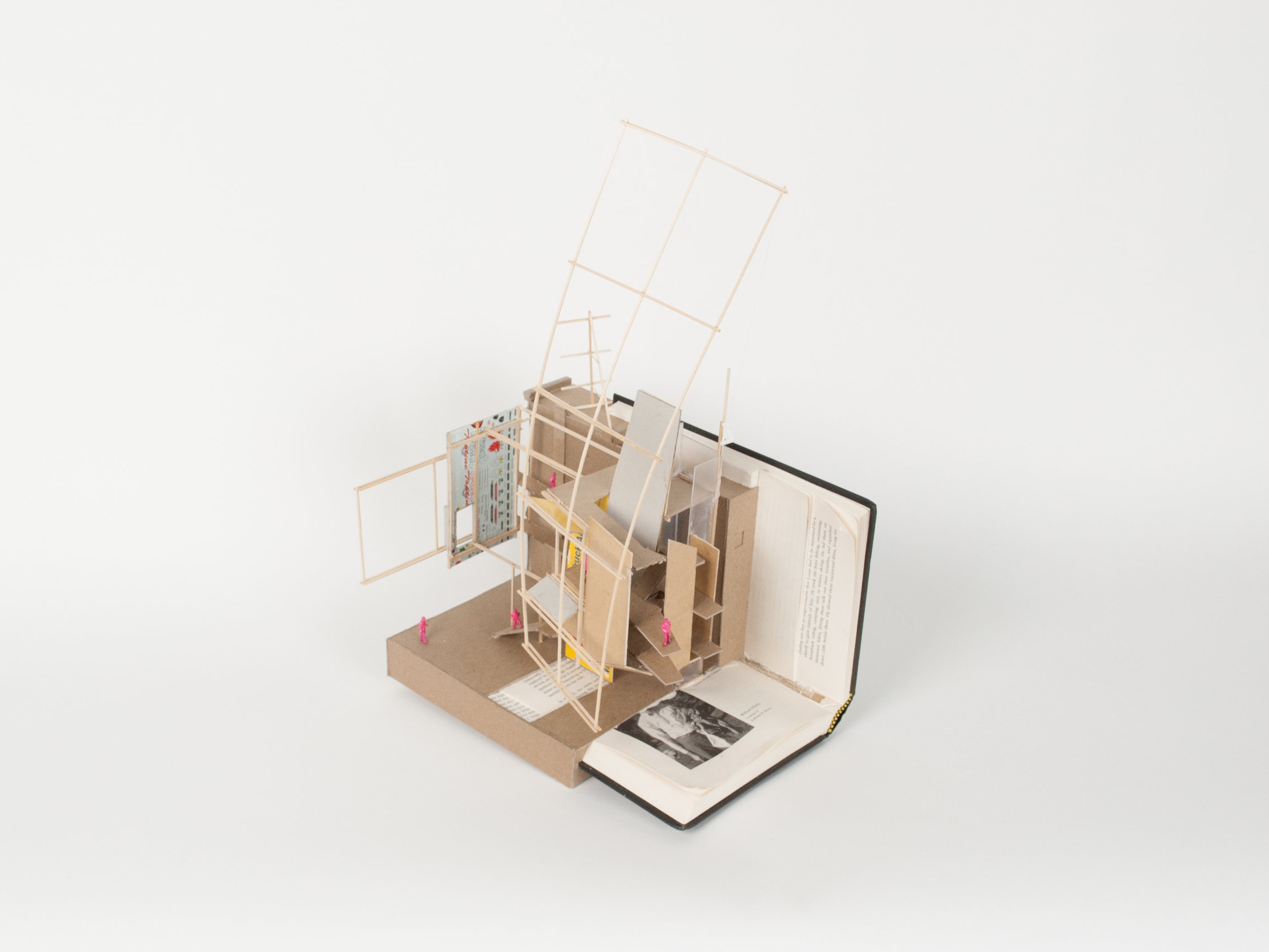Collisions: From Analog to Digital
the cybernetics of drawing, movement, and materiality
Spring 2017
advisors: Joseph Krupczynski & Carey Clouse
Honorable Mention: 2017 Innovative Minds Cybernetic Framework Competition
Design Excellence Award: 2017 AIAS Honor Awards
click here to download the presentation boards
click here to download full manuscript
Preface:
Amidst the surfacing of the digital “canvas” and the image first-platforms of today’s consumer culture, the drawing has been pulled in a number of different directions. Within architectural education & practice, it has become at odds with the seductive and the interpretative, the hand and the machine, and the subjective and the objective.
To tackle these issues, an investigation of architectural representation & theory offered key insights. Subsequent research moved the project to a study of discursive imagery, a form of representation that:
a) suggests a path non singular in its direction
b) encourages an architectural discourse in the space that it is perforating
c) functions beyond an objective, reductive set of instructions for building
Using the discursive image as a primary vessel for investigation, the speculation of an urban interface that explores sequences of collisions between divergent entities ensued.
Three divergent entities were identified:
a) old and new
b) body and materiality
c) narrative and fragment
To explore these collisions, creative efforts were organized into three phases of production:
a) drawing as performative filter
b) model as movement sequence
c) site as materiality
These phases were used to organize the project, with each part outlining the processes, artifacts, and divergent entities that were gathered.
Although the exploration culminates with the proposal for an urban receptor that synthesizes moments of collision, the project also attempts to offer a new [cybernetic] design strategy – one that employs discursive imagery and narrative structures.
Part I:
Drawing as Performative Filter
This is not to accept that the development of an idea into architecture need be fixed so resolutely. In this relationship the drawing potentially offers itself as an interrogative apparatus that has the capacity to critically engage with the production of architecture. That it is rarely used this way says much about the translatory relationship of both architect/building and idea/architecture.
– Peter Cook
01.
Tracing Things
The Plug In-City
In this performance, the body is interested in the interplay of different perspectives and different speeds. For all the digitized social interactions it sees, the body is dissatisfied with its isolation. In response, it seeks a tactile action sequence. The conveyor belt and dump truck are brought into the scene, and they begin to organize the trash [information], connect the unseen [bodies], and in doing so, break the picture plane. Consequently, the machines’ precise degree of measure begins to erode.
02.
Illegible Passages
The Uses of Sidewalks
In this performance, the body has accepted the machine as an inseparable prosthetic. The union between the two has allowed for vertical passage along the sidewalk, giving it a new place to view the digital city from. Scrolling [reading] the digital has become mechanized [analog] again. Nonetheless, the body [creature] is disheartened to realize that information does not equate to knowledge. To fully make connections, the creature now understands that it will have to encounter an unseen geography or infrastructure – by violating it.
03.
Translating Text
The Reductive Book Sequence
In this performance, the creature [body] has become interested in the translations between the analog and the digital. The machine is now fully eroded; it is fleshy and violent. It has taken to the pages of a book and begins by relaying, augmenting, and topologically transforming them. Although the text has remained, the narrative is different. Just like the blueprint of the machine, the book has been reduced to an objective set of instructions. Curiously, the creature has remained suspended in the interstitial space – the collision threshold – the crash.
04.
Projecting Narratives
Enacting the Histories of Fedora and Ersilia
In this performance, the creature has become infatuated with visiting the Invisible City. To do so, it has latched onto its book – twisting and folding itself into a well-seated projection terminal. However, to visualize the unseen, it must rely on the imaginations of those that choose to pass through its center. This action sequence is closest to a symbiotic relationship; the creature presents Ersilia’s spider-web of connections [pragmatism], and the body offers its crystal orb [optimism] of Fedora. Using the spider-web as a screen, the creature projects the body’s orb onto it. The light seeps into the cracks and edges of the web, and the Invisible City is finally seen in the shadows cast.
05.
Filtering as Archiving
DEMATIC Operations
In this performance, the creature has met competition – the DEMATIC automated library system, a champion of speed and efficiency. Jealousy [seduction] takes hold of the creature, and its functions slow. In that instant, however, it remembers why these feelings have spread: because it is part human. Unlike the creature, DEMATIC lacks curiosity. It doesn’t have the body to regulate its switchboard of connections – to directly engage in a critical discourse. The creature, however, uses the body to filter ideas, speculate potential, and regulate function. From that moment forth, the creature never took its identity [site] for granted again, and it archived the memory close to center.
Part II:
Model as Movement Sequence
It is fitting that the detritus of an older, industrial age be used to examine lost relationships between the body and building, since many of the found pieces bear traces of the body in their production.
– Dan Hoffman
A.
Sectional Passage
Spatial Sequence 01
In this movement sequence, the creature has folded into a framed passage way. To break up the saturation of images the body will encounter, the creature uses the section. It decides to cut into the signs along the path and situate them on a series of thresholds [frames]. The configuration is such that there are multiple ground planes [interpretations]. The envelope of the passage undergoes similar operations of fragmentation and folding, bringing in light to the lonely [decorporealized] body. It is grounded using the parts of an eroded crane.
B.
Silence and Noise
Spatial Sequence 02
In this movement sequence, the creature has folded into a suspended passage way. The body, wishing to hover between the silence of the library and the noise of the performance, can only do so temporarily – it is a difficult task [collision]. The vessel the body sits in is unstable, malleable, and dependent. It is the interstitial space of movement. It sways with the forces surrounding it, propped up by the eroded parts of a tractor trailer shell [screen].
C.
Theatrical Tension
Spatial Sequence 03
In this movement sequence, the creature has folded into a theatrical passage way. Rather than view the performance, the body wishes to augment it. Consequently, it programs the creature to erect a series of mirrors, windows, and lines within the passage – some are floating above one another, others conjoined to its cables. This gives the body a costume to wear while on stage. The tension that arises is a strange one; the body is neither on stage nor sitting in the audience – rather, it is trapped between the two. The production crew [site] is [happily] surprised at the manner in which the spotlights pass through the passage and onto the stage.
Part III:
Site as Materiality
This is a condition that I have labelled ‘postliminal fuzz’ – a circumstance of the recognition of liminal space, the physical and conceptual properties of the drawing surface and the production of new policies based on their collision(s).
– Bryan Cantley
06.
The Palimpsest
Urban Parasites
In this performance, the creature has found a [new] palimpsest. It seeks surfaces that are rich in texture and histories. Previously, its palimpsest was a book of stories. Now, it is the exposed brick wall of Hotel Jess and the earth of an adjacent lot. To engage with site, it remains mobile and in its most recent state of configuration: the movement sequence. Like before, it will soon twist, fold, and topographically transform.
07.
Delayed Seduction
Bridging Text and Image
In this performance, the creature has been seduced by its own image. With the body removed, the creature makes little effort to critically engage with the wall – it takes it for granted. It doesn’t seek the idiosyncrasies, the broken, the haptic. It ignores what the section may yield. It is only concerned with alluring the attention of the passing trains. Although the creature has begun to fold, twist, and augment its own text, it avoids cutting into the brick to uncover a new narrative. Until it does so, it will be caught in the limbo of Zeno’s paradox.
08.
Indexical Fragments
The Subtractive Window
In this performance, the creature seeks to subtract the shell separating the visible and invisible, the allowed and the prohibited, the interior and the exterior. By violating the brick wall [site] separating the two, it has removed the threshold of collision between the light and dark. The indexical cuts have given the parasite new windows into the building’s history, but fragments and voids remain disjointed – there is no more surface to ground the architectural elements in. Consequently, the window must now find a new receptor to live in. The creature, once anxious, is now satisfied – it has tricked its producer.
Part IV:
Urban Collision [Receptor]
Taking the ordinary environment as their “new theater of operations in culture,” in the phrase of the Situationalists, these artists challenged its exclusion from the gallery, the museum, or the performance space. They sought to examine how architecture, consumerism, advertising, the mass media, suburbanization, culturally sanctioned gender roles, and notions of domesticity maintained relations of control in bases whose naturalness and benign function appeared increasingly dubious.
– Edward Dimendber
Synthesis Model
Filtering Isaac Asimov’s Fantasies
In one of its final performances, the creature has found the ideal stage to debut its newest piece on. It is neither the screen, the wall, nor the page. Rather, it is the passage that creates a new void in-between. The body longs to read the wall [book] within, but doing so requires entry. Those that take its passage, however, soon realize that they have a been seduced by a newer narrative along the way – one that has perforated [violated] the space that they are ascending.
Design Proposal
This design proposal is an ongoing speculation of an urban interface that explores the sequences of collisions between old and new, body and materiality, and narrative and fragment. Rendered as a piece of infrastructure, the space mediates a number of different social interactions [collisions]:
(i) it performs as a receptor for a new pedestrian bridge that reconnects lower Holyoke to the flats
(ii) it performs as a highly visible marker of cultural identity in Holyoke
(iii) it performs as a drive-in movie theater and/or stage for oral presentations
(iv) it performs as a passage into the former Hotel Jess, which will soon be redeveloped as a public theater space
(v) it performs as a scaffolding for graffiti artists
(vi) it performs as a billboard for passing trains
(vii) it performs as a catalyst for an urban plaza below
views from the west and south
physical model
plan view at 2nd level – entry into hotel jess
south section – urban collision zone
